► The best supercars on sale in 2024
► CAR magazine’s top supercar picks
► Featuring Ferrari, McLaren, and Porsche
Attempt to draw up a list of the best supercars of all time and you will find yourself faced with some interesting questions. Was the 1954 Mercedes 300 SL ‘Gullwing’ the first supercar? Or the 1965 Shelby Cobra 427? Arguably, it was the 1966 Lamborghini Miura that established the template: traffic-stopping style, a stentorian engine mounted in the middle and a hedonistic disregard for practicality or price. Its ancestors have enthralled enthusiasts, topped best new car lists, engorged egos and emptied bank balances ever since.
Perhaps searching for a pioneer or archetype misses the point. Styling and aerodynamics constantly evolve, limits of power and performance are pushed, yet any seven-year-old can still identify a supercar on sight. Looking and sounding sensational are as imperative as speed itself. A Ferrari Testarossa might lose a drag race to one of the cheapest new sports cars around, but only the Ferrari belongs on a bedroom wall.
The best supercars 2024 at a glance
That drama is amplified from behind the wheel, as countless CAR adventure stories can attest. Perhaps the most famous is Convoy!, the February 1977 cover feature by then-editor Mel Nichols. His account of a 1000-mile road-trip from Modena to London, driving three Lamborghinis – Countach, Silhouette and Urraco – captures the sense of occasion perfectly, and has become part of motoring folklore.
But what if you want to sample some of that drama yourself? Despite supercars being comparatively uncommon, and only offered by a handful of manufacturers, there is still a wide array of choice out there when it comes to super-sport cars. Some care is required; a lot of exotic cars are very focused, and better serve as the best track day cars around, which might not fit your requirements. So, we’ve come up with a list of the best supercars using our long-standing CAR GBU – the Good, the Bad and the Ugly data section – data section and our numerous tests, allowing you to identify the best supercar for you in 2024. Read on for our selection of the best supercars on sale, then follow the links for full reviews of each one. Whether you’re a dreamer or a driver, there’s much to enjoy.
Best supercars in 2024
Ferrari 296 GTB
A terrific hybrid supercar
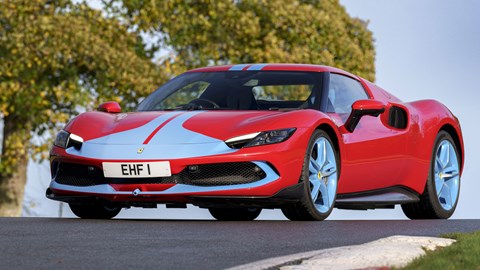
Pros: Timeless styling; sublime driving experience; convertible GTS option
Cons: Quick reflexes required to get the best out of it; terrible touch-pad controls on the wheel
Mention hybrids in casual conversation and someone in the background will probably yawn. Tack the word Ferrari onto it, however, and ears will prick up. Mention 819bhp and, well, you’ll probably have the attention of everyone around. But power isn’t just why the Ferrari 296 GTB is at the top of this list; the hybrid V6 supercar is one of the finest Ferraris in years, offering incredible handling, superb performance, and accessible fun, in a sublime package.
And that’s before you start considering facets such as its ability to cruise for up to 16 miles – okay, that’s the claimed figure – on electric power alone, allowing you to quietly and considerately depart from home before unleashing its advanced twin-turbocharged 3.0-litre V6 in earnest. Just remember to pick your colour scheme carefully, in order to best show off its 250LM-derived styling.
For a more in-depth look read our Ferrari 296 GTB review
Porsche 911 GT3
Blending race car with road car
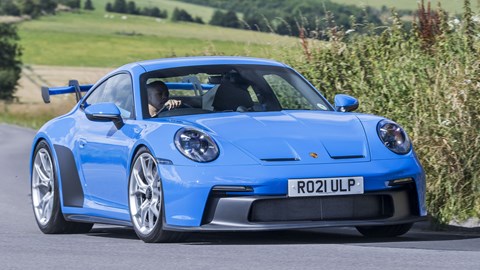
Pros: Evocative engine noise; total driver immersion; 9000rpm redline
Cons: Getting hold of one, like others here; very little, otherwise
If you’re mourning the death of the naturally aspirated engine, or you’re seeking one of the most immersive driving experiences around, a 911 GT3 could be just the ticket. Its 4.0-litre boxer engine is an absolute masterpiece, delivering high-rev, super-crisp exhilaration and a heady 503 naturally aspirated horsepower. This, coupled with the GT3’s race-bred chassis, helps make the GT3 one of the finest and most engaging road cars around.
And if it’s not extreme enough, well, you could always step up to the 911 GT3 RS, a car dripping with focus while cleverly retaining the usability and approachability of the conventional GT3. Alternatively, if you want something a bit softer and better suited to pothole-strewn roads, take a look at the Porsche 911 Dakar.
For a more in-depth look read our Porsche 911 GT3 review
McLaren Artura
Compelling long-distance companion
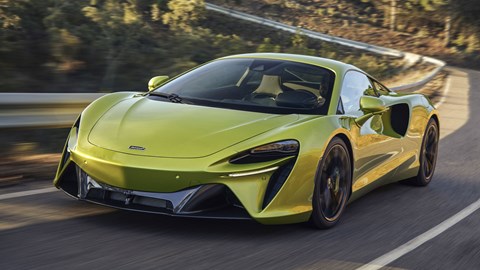
Pros: Thrilling to drive; pleasingly usable; high-performance hybrid powertrain
Cons: Not as evocative as some; quality control issues; missing a little charisma
While this new McLaren may echo many of the Sports Series cars that preceded it, it actually represents a significant step forward for the brand. Underneath its familiar yet clean-sheet exterior design, it features a new platform, new architecture, and a new V6-equipped hybrid powertrain. And, like previous McLarens, it majors on delivering thrilling yet truly usable performance, blended delightfully with long-distance comfort and the handling you’ve come to expect from the fabled brand.
In the past, we described the MP4-12C – the first of the modern-era McLaren supercars – as ‘the most complete supercar the world has ever seen.’ The Artura might not quite live up to that heady accolade, at least not yet, but it is an impressive and capable supercar, and one that’s more nuanced than many a rival. If the alternatives leave you wanting, particularly when it comes to the breadth and depth of their abilities, this could be the one for you.
For a more in-depth look read our McLaren Artura review
Ferrari SF90 Stradale
A fascinating electrified Ferrari
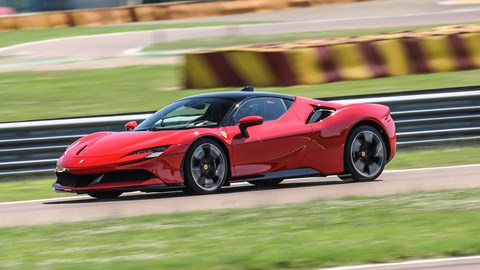
Pros: Warp-speed pace; long-distance comfort; remarkable technology
Cons: Limited practicality; additional weight and complexity
Ferrari’s SF90 Stradale is a production supercar that pushes the envelope. It packs a mighty 1000 metric horsepower, generated by three electric motors and a twin-turbocharged V8, which allows it to dispatch the 0-62mph dash in just 2.5 seconds, and the 0-100mph benchmark in only 6.5 seconds. It’ll also do up to 84mph on electric power alone, making it vastly less conspicuous when you want it to be.
There’s more to it than just its complexity and specification-sheet feats, mind; despite its incredible performance figures, the SF90 Stradale is a terrifically quick car that’s also flattering, easy to drive, and enjoyable. Only a few foibles, such as limited luggage space – even by supercar standards – dint its appeal.
For a more in-depth look read our Ferrari SF90 Stradale review
Chevrolet Corvette Z06
Comparatively affordable exotica
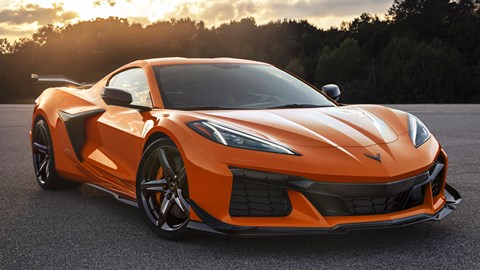
Pros: Great all-round package; nimble and exploitable; naturally aspirated V8
Cons: Styling is a bit hit and miss; interior quality and kit not quite there
The appearance of a Corvette in this list might make you raise an eyebrow, but bear with us: the C8-generation Chevrolet Corvette Z06 is not like anything that has gone before. The mid-engined Chevrolet is outfitted with a 8600rpm naturally aspirated flat-plane 6.2-litre V8, granting it 661bhp and more European flavour than you might expect.
And it’s not just about straight-line punch; the Z06 serves up a driving experience that’s similarly cultured, with a resolved chassis, good ride and agile and exploitable handling. Sure, there are some quality issues, but it’s hard to argue with the well-rounded nature of its package considering its more affordable price.
For a more in-depth look read our Chevrolet Corvette Z06 review
Lamborghini Revuelto
Ultimate thrills from the last V12 Lamborghini
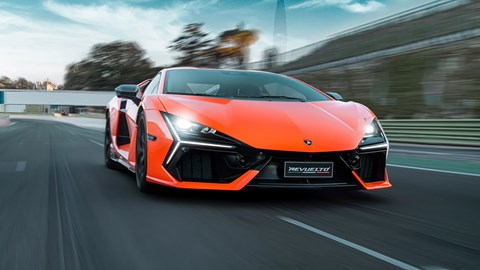
Pros: Jaw-dropping performance; furiously fast; not overly sanitised
Cons: We’ve not driven it in the UK yet; busy instruments; hefty price
This is it, folks, the last Lamborghini – reputedly, at least – to feature a naturally aspirated V12. That alone makes it worthy of note, but there’s much more to the Revuelto than its engine configuration. It’s equipped with an incredible hybrid powertrain that produces a whopping 1001bhp, granting 0-62mph in 2.5 seconds, 0-124mph in 7.0 seconds (!) and a top speed of 217mph. The 6.5-litre engine alone makes 813bhp, all the way at a spine-tingling 9250rpm, 250rpm shy of its heady redline.
And its electric shove helps cleverly conceal its 300kg weight penalty over an Aventador, and it feels – remarkably – lighter, more agile, more alert. It is incredibly striking, incredibly quick, incredibly engineered and deeply impressive to drive. As a result, it is a fitting swansong for the brand’s use of the naturally aspirated V12. The only thing to give us pause for thought is that we’ve not tested one on the road yet.
For a more in-depth look read our Lamborghini Revuelto review
Maserati MC20
Vibrant MC20 is hard to fault
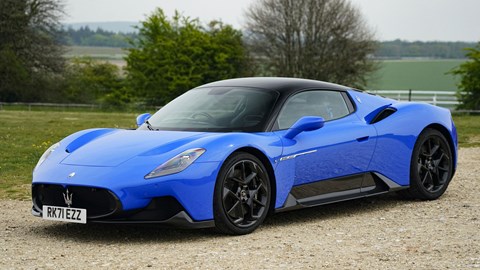
Pros: Beautifully resolved and finished; agile and composed; easy to live with
Cons: Tuneless engine; cabin lacks some flair; limited luggage space
Maserati has finally returned to the two-seat supercar sector and, joyously, its new MC20 has been worth the wait. The mid-engined Maserati packs an advanced twin-turbocharged 3.0-litre V6 that produces 621bhp, all of which is sent to the rear wheels, allowing the carbon-structured MC20 to get from 0-62mph in just 2.9 seconds – so it certainly stacks up on the performance front.
What’s more impressive is how it drives. It handles as well as many a modern Ferrari, and serves up immense acceleration and stopping power, while being compliant and supple enough that it’s pleasant and approachable on even wintry British roads. There’s a real sense of polish and verve to the entire package, which helps make this newcomer hold its head up among the established competition. The only snag is that the engine is nowhere near as aurally evocative as Maseratis as old but, given its performance…
For a more in-depth look read our Maserati MC20 review
Lamborghini Huracan Tecnica
The finest Huracan
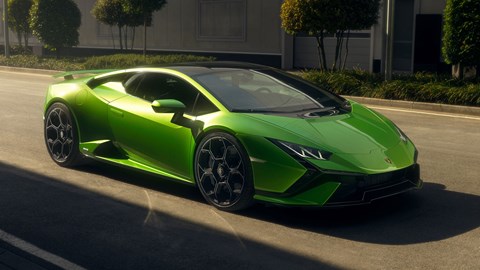
Pros: Evocative V10 engine; beautiful controls; confidence-inspiring behaviour
Cons: No custom driver modes; raw figures won’t impress some
The Huracan’s been around for a long time now, but Lamborghini’s ongoing fettling and fiddling mean that it’s still capable of kicking up a storm. And, in the case of the Tecnica version, the company’s tweaks have resulted in a terrifically desirable and captivating car. It is devastatingly quick, thrilling to drive, and yet approachable and enjoyable, and fans of natural aspiration will lap up every revolution of that astonishing V10. Some, however, may find the on-paper figures a little lacking compared to the latest in mainstream hybridised supercar offerings.
Lamborghini’s range is worth a look in any case; the rough-road-oriented Huracan Sterrarto, for example, is ideal if you fancy venturing off the beaten track from time to time. If you fancy something a tad more subtle, and a mite easier to live with, you could instead opt for the Audi R8 – but production is drawing to a close, so you’ll have to move quickly if you want a new one.
For a more in-depth look read our Lamborghini Huracan Tecnica review
Ferrari 812 GTS
Powerful, thrilling, and challenging
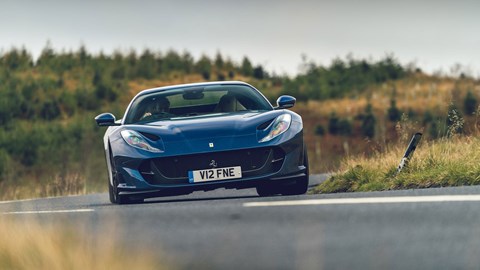
Pros: Searingly, heart-poundingly aggressive
Cons: Searingly, heart-poundingly aggressive
Don’t be fooled by the front-mounted engine, coupe silhouette or lack of aero appendages. It may look like a muscle car in an Armani suit, but this is one of the most high-functioning, head-spinning machines here. The naturally aspirated 6.5-litre V12 in the 812 GTS revs to 8900rpm and feels utterly unhinged. It yelps and howls like Robert Plant on Whole Lotta Love. And it blasts the GTS from zero to 62mph in less than 3.0 sec. Flat out, it’ll exceed 211mph. We need a lie down just thinking about it.
On the road, an E-Diff, F1-Trac stability control and rear-wheel steering help muzzle the salivating maniac out front. On a track, you can flick the manettino to ‘CT Off’ and shred rubber. Either way, corralling 789 prancing horses tends to focus the mind. And with the roof down, you’ve a front-row seat for that V12 orchestra. But with such aggression, and with facets such as just 210 litres of luggage space, it’s arguably too intense to be a long-legged GT; something from Aston Martin or Mercedes will better fill that brief. On the right road, though – preferably a very long and empty one – the Ferrari is transcendent.
For a more in-depth look read our Ferrari 812 GTS review
Supercar buying guide
Buying a supercar isn’t a rational decision, so the usual buying guide tips don’t apply. CarPlay and cupholders be damned: if you ache to own it, go forth and live the dream. The cars we’ve chosen might be infinitely more advanced and powerful, but all are capable of recreating that Convoy! article magic.
It’s best to see the price of a supercar as merely the starting point. We’ve never tested the urban myth that Ferrari refuses to sell a ‘standard’ car – let us know if you have – but you should probably budget well into five figures for extras. Many of the supercars we’ve tested have tens of thousands of pounds worth of extras, and that’s before you get into the endless options for personalisation. Be careful your taste doesn’t torpedo the resale value.
Speaking of values, you can buy a supercar and make money. Some automotive influencers repeatedly do just that. The key is to choose low-volume or limited-edition models, ideally with a long waiting list. However, assuming you have the cash upfront, the biggest hurdle will be pushing to the front of the queue. Unless you’re a loyal customer, you may be politely ignored.
Best supercars of 2024: FAQs
What is a supercar?
A supercar, broadly speaking, is a car that delivers an incredible experience across the board: incredible performance, handling, stopping power, presence, styling, technology, design, and ownership experience. Production numbers are usually low which, coupled with all of the prior, entails an incredible price tag for each supercar. Most modern supercars generally have more than 600bhp and are capable of 0-62mph in less than 3.5 seconds and north of 200mph. Anything that’s significantly more powerful, quick, fast, and produced in lower numbers, is usually called a hypercar.
What is the king of all supercars?
That depends on what you deem important in a supercar. If you deem a supercar all about extremes, for example, then something such as the quad-turbocharged Bugatti Chiron could be a contender for the title of supercar king. But that, for many, would slip into the realm of hypercars, not supercars. If you were to ask us, though, we’d probably settle on the McLaren F1. It might be old, but the naturally aspirated V12 wonder is still held in the highest of regards, thanks to its elegant styling, compact footprint, remarkable design and evocative driving experience. For many, it was the pinnacle of the supercar concept, and it’s often considered the best driver’s car ever built. In 1994, we dubbed it ‘the greatest supercar of them all’.
What is the classiest supercar?
This is a little subjective, as some might deem the likes of the McLaren F1 or succeeding T.50 the classiest, because they are small, elegant, and not ostentatious. See also: a lot of the newer McLarens, as their subtle designs don’t shout about their presence. Others, on the flip side, might consider supercars with a more subtle grand touring edge the classiest, such as the Aston Martin DB12 or Ferrari FF. In short, the less shouty it is about its existence, and the higher the standard of its finish, the classier it is.
What’s the most affordable supercar?
The Porsche 911 GT3 might not be considered a supercar by some, but it offers one of the most engrossing and exhilarating driving experiences around – and, usefully, it’s also one of the most accessible, in terms of price. You’ll pay around £150,000 for a new one, provided you stay away from the options sheets, although you might admittedly struggle to actually get that far down the line with a dealer. Otherwise, Chevrolet’s Corvette Z06 and the Maserati MC20 are less expensive than some of the headier competition here. If you want supercar-like performance on a budget closer to one of the best cheap sports cars, you could go for a £50,000 Ariel Atom 4 instead.
What is the fastest legal supercar?
The sands shift a lot in this area, with oft-claimed figures rapidly being dismissed or disproven, or the legality of certain options being cast into doubt, but if you’re looking for devastating real-world performance, the Rimac Nevera is certainly up there. The all-electric Nevera has 1,888bhp and is capable of 0-62mph in 1.81 seconds and, remarkably for an EV, it can reach 256mph. If you’re talking about outright top speed, however – ‘fastest’ – then the Jesko Absolute is a strong contender, with an estimated top speed well in excess of 300mph.
What is the fastest British supercar?
The McLaren Speedtail is claimed to have a top speed of 250.4mph, making it the fastest British supercar around. Even newer contenders, such as the ferocious Aston Martin Valkyrie, are limited to 220mph in road-going trim. McLaren otherwise has a long history of building the fastest around; its fabled McLaren F1 of 1992-1998, in independently measured testing at the Ehra-Lessien test facility, an F1 set an average top speed of 240.1mph in 1998. Okay, its limiter was tickled a little, but other F1s have exceeded 230mph, or demonstrated themselves capable of it.